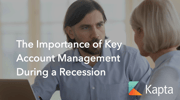Recession-Proof Your Business with Strategic Customer Engagement
in Strategic Account Management, CRM, Customer Engagement, Key Account Management /Is your business recession-proof?
Economic experts continue to have conflicting predictions about the likelihood of a recession in 2024. Some say that the threat has passed while others believe it’s inevitable.
Recessions typically result in reduced sales and staff layoffs while credit access tightens along with increased loan defaults and bankruptcies.
With so much at risk, why not proactively recession-proof your business to ensure the best possible outcome in an economic downturn? Businesses that are well-prepared ahead of a recession are better positioned to survive or even thrive during and after the recessionary turmoil, according to Bain.
There are a variety of actions you can take to recession-proof your business such as reducing debt, increasing cash reserves, containing costs before considering layoffs, and focusing on customer retention.
This last action applies especially to your top-tier customers representing up to 80% of your annual revenue. Shoring up these clients is good for your business regardless of the economic environment, but is particularly crucial during economically challenging times.
You can accomplish this through a strong customer engagement strategy. How do you recession-proof your business with customer engagement?
Develop Customer Knowledge
Arm yourself with deep insights and information about your VIP clients. This can be accomplished by taking steps like:
Creating detailed org charts and contact profiles to better understand the bigger picture and the inner workings of their organization.
Conducting voice of customer (VOC) interviews to reveal your client’s goals, priorities, and challenges and learn how they think about them.
Completing a SWOT Analysis to gain a clear picture of the strengths weaknesses, opportunities, and threats relating to the client and your partnership.
Developing an extensive understanding and knowledge of your key accounts enables you to help them attain the outcomes they want to achieve by using your product or service. This is essential since consistently receiving measurable results is the best predictor of customer retention.
Act on What You Know
Once you know who your customer is and understand their goals, priorities, and challenges, it’s time to draft an account plan to help them achieve these outcomes with your product or service.
Plot out all the tasks and actions required by both you and your customer to reach these goals. Then communicate and build mutual agreement on this plan of action internally and with the client. The customer engagement team and the customer must complete their designated tasks to drive the desired outcomes.
Measure and Report Results
As the account plan is created, it’s crucial to identify customer-preferred KPIs to measure progress toward goal achievement. Then monitor the designated metrics and report back to the customer.
Manage the account plan as you would any project, checking off tasks, holding people accountable for their role in the plan, and ensuring you stay on schedule. Adjust the plan and timetable as needed based on delays and goal changes.
Customers are busy, so alert the customer when their desired outcomes have been achieved so they can see the value they are receiving from your partnership. Then, identify the next customer goals and create and implement the next account plan.
Establish Consistent Communication
Ongoing communication with the customer and across the customer engagement team is crucial so everyone stays on the same page.
Document all details in a central location that’s easily accessible by all team members so they’re always up to date when engaging with clients. This also facilitates sharing their findings with the entire team in the flow of their day-to-day work.
Complete routine internal account reviews to gauge risk and discuss or adjust strategic plans. Then meet with the customer regularly and engage them between meetings to stay abreast of the client’s evolving status and provide progress updates regarding goal attainment.
Implement a Customer Engagement Process
Make it easy for your team to complete all these tasks efficiently without missing a beat by establishing a formal customer engagement process like our KAM Process™. Implementing a process acts as a roadmap so account managers always know what’s next for each of their clients without hesitation. This repeatable cycle ensures that you always have the most current information regarding a customer and can adjust account plans as the customer’s needs and priorities change.
This process also simplifies and accelerates the achievement of measurable customer outcomes and boosts customer retention at times when your team may be doing more with less.
Practice Proactive Risk Management
Risk is an inevitable element of customer engagement that can result in low satisfaction, reduced revenue growth and stability, unexpected customer churn, and poor employee morale.
Therefore, it’s essential to stay ahead of it.
You can do this by teaching team members to recognize at-risk accounts before problems develop, asking your account managers questions about these clients, gauging the risks, and developing a plan to overcome the risk. Overall, it’s crucial to understand potential risks and be prepared to address them so you can minimize their impact on your business.
Leverage Technology
Using purpose-built customer engagement technology, like Kapta, allows your team to document everything in a central location, including account plans, so it’s easily accessible to everyone in your organization who engages with the customer. A platform of this type also facilitates internal and customer communications and acts as a guide while streamlining activities throughout the customer engagement process.
Providing your customer engagement team with this complete solution is like giving your them a Swiss army knife since it’s loaded with all the tools they need to succeed as account managers.
Recession-Proof Your Business with Strategic Customer Engagement
Will there be a recession this year? Nobody knows for sure.
Reduce your risk by proactively recession-proofing your business with customer engagement.
Have your team develop customer knowledge, act on what they know, measure and report results, and communicate consistently with customers and colleagues. Then implement a formal customer engagement process, practice proactive risk management, and leverage purpose-built technology.
This sets you up to survive and thrive before, during, and after any recession that comes your way.
Learn the latest in customer engagement techniques. Register for KAMCon.







